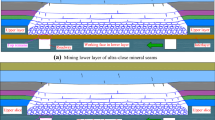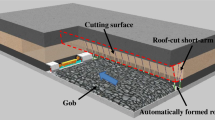Abstract
Most accessible mineral deposits are nearly exhausted. Consequently, some resources that were previously abandoned are now being considered for remining. This paper describes a case study that aims at revealing the instability mechanism and selecting the optimal control countermeasures for a cataclastic roadway regenerated roof (CRRR) during the extraction of the remaining mineral resources. Based on the structural model of a cataclastic regenerated roof (CRR) of a remaining lower slice, a modified natural arch mechanical model for a CRRR was established by considering the lateral pressure and stress concentration coefficient of the bearing arch, through which the modified bearing arch curve equation and arch rise expression were deduced. The relationship between the modified arch rise and the lateral stress was obtained through a practical case. Next, a numerical model of a CRRR, which accounted for the cataclastic features, was built in the Universal Distinct Element Code (UDEC). The development of subsidence and fractures in the roadway roof was determined through modeling under various roof support scenarios, namely no support, rock bolt (RB) support, rock bolt and cable (RBC) support and a combined support of the rock bolt, cable and steel beam (RBCS). The theoretical analysis, numerical simulation and monitoring results of the RB and RBC stress all indicated that a bearing arch existed in the CRRR and that the arch rise underwent changes during the roof hanging time and with different support scenarios. The support structure should exceed the bearing arch rise in height and should be leak proof to avoid roof leakage. After a comparative analysis of the numerical and field support effects provided by various supporting scenarios, the RBCS support scenario was shown to be the optimal roof support choice, providing a good controlling effect for a CRRR and meeting the production requirements.





























Similar content being viewed by others
Abbreviations
- \({k}_{\rho }\) :
-
Broken expansion coefficient of caved rocks
- \({H}_{\rm c}\) :
-
Mining height
- \({H}_{\rm m}\) :
-
Roof caving height
- \({H}_{\rm a}\) :
-
Irregular caving sub-zone height
- \({H}_{\rm b}\) :
-
Regular caving sub-zone height
- \(K_{\rho }^{\prime }\) :
-
Residual broken expansion coefficient
- \({H}_{\rm r}\) :
-
Caving zone height after compaction
- \(H_{{\text{a}}}^{\prime }\) :
-
Irregular caving zone height after compaction
- \(H_{{\text{b}}}^{\prime }\) :
-
Regular caving sub-zone height after compaction
- \({H}_{\rm s}\) :
-
Sinking height of main roof
- \(n\) :
-
Total rock layer number in main roof
- \({H}_{\rm f}\) :
-
Water-conductive fissure zone height
- L 1, L 2, L 3, L 4 :
-
Serial number of each rock layer in main roof from bottom to top
- \(\sum M={H}_{\rm c}\) :
-
Mining height
- \({L}_{0}\) :
-
Initial fracture span of rock layer in main roof
- \({\sigma }_{x}\) :
-
Tensile strength
- \({M}_{\rm c}\) :
-
Thickness of the follow-up layer
- \(\alpha\) :
-
Dip angle of rock layer
- Z 1, Z 2, Z 3 :
-
Regenerated zone after cementation, weakly cemented compaction zone, fractured zone
- γ :
-
Average volume weight of rock strata
- H :
-
Depth below surface
- λ :
-
Lateral pressure coefficient
- q :
-
Uniformly distributed load
- 2a :
-
Roadway width
- P :
-
Lateral stress acting on the arch
- T :
-
Horizontal thrust from the right arch
- W :
-
Thrust along the arch tangential direction
- F :
-
Friction force
- N :
-
Reaction force
- f j :
-
Rock consolidating coefficient
- T 1 :
-
Horizontal thrust at point A
- η :
-
Safety factor
- c :
-
Vertical semiaxis length of the ellipse
- \(c\sqrt{\mu }\) :
-
Horizontal semiaxis length
- b :
-
Arch rise of the modified bearing arch
References
Bai JB, Shen WL, Guo GL, Wang XY, Yu Y (2015) Roof deformation, failure characteristics, and preventive techniques of gob-side entry driving heading adjacent to the advancing working face. Rock Mech Rock Eng 48(6):2447–2458
Bai QS, Tu SH, Zhang C, Zhu DF (2016) Discrete element modeling of progressive failure in a wide coal roadway from water-rich roofs. Int J Coal Geol 167:215–229
Bergman SG, Bjurstrom S (1983) Swedish experience of rock bolting: a keynote lecture. In: Proceedings of the international symposium on rock bolting. Abiko, pp 243–255
Brady BHG, Brown ET (1985) Rock mechanics for underground mining. George Allen & Unwin, London, pp 212–213
Colwell M, Frith R (2006) Why uniaxial compressive strength and Young’s modulus are commonly poor indicators of roadway roof stability-except in the tailgate. In: Coal operators’ conference. University of Wollongong & the Australasian Institute of Mining and Metallurgy, Wollongong, pp 28–43
Gao FQ, Stead D (2013) Discrete element modeling of cutter roof failure in coal mine roadways. Int J Coal Geol 116–117:158–171
Guo WJ, Liu WT, Zhang WQ (2008) Special mining of mine. Coal Industry Press, Beijing, pp 125–126 (in Chinese)
Hoek E, Brown ET (1980) Underground excavations in rock, 1st ed. Institution of mining and metallurgy, London, pp 83–102
Huang QX, Liu YW (2014) Ultimate self-stable arch theory in roadway support. J Min Saf Eng 31(3):354–358
Islam MR, Shinjo R (2009) Numerical simulation of stress distributions and displacements around an entry roadway with igneous intrusion and potential sources of seam gas emission of the Barapukuria coal mine, NW Bangladesh. Int J Coal Geol 78(4):249–262
Jiang LS, Mitri HS, Ma NJ, Zhao XD (2016) Effect of foundation rigidity on stratified roadway roof stability in underground coal mines. Arab J Geosci 9(1):1–12
Jiang LS, Zhang PP, Chen LJ, Hao Z, Sainoki A, Mitri HS, Wang QB (2017) Numerical approach for goaf-side entry layout and yield pillar design in fractured ground conditions. Rock Mech Rock Eng 50(4):1–23
Jiao YY, Song L, Wang XZ, Wang XZ, Adoko AC (2013) Improvement of the U-shaped steel sets for supporting the roadways in loose thick coal seam. Int J Rock Mech Min Sci 60(2):19–25
Kovari K (1994) Erroneous concepts behind the New Austrian Tunneling method. Tunn Tunn 4:38–42
Li JP, He FL, Yan H, Jiang HJ (2012) The caving and sliding control of surrounding rocks on large coal roadways affected by abutment pressure. Saf Sci 50(4):773–777
Li TC, Lu Z, Liu JZ, Ma XQ (2014a) Deformation and failure process analysis of rectangular roadway in muddy weakly cemented soft rock strata. Rock Soil Mech 35(4):1076–1083
Li WT, Wang Q, Li SC, Wang DC, Huang FC, Zuo JZ, Zhang SG, Wang HT (2014b) Deformation and failure mechanism analysis and control of deep roadway with intercalated coal seam in roof. J China Coal Soc 39(1):47–56
Liang XD, Zhao J, Song HW (2012) Experimental and numerical analysis on the arching action from stress adjusting in surrounding rocks. J Eng Geo 20(1):96–102
Lu C, Cheng WY (2008) Analysis of stress arch action and preventing roof falling in laneway engineering. J Saf Sci Tech 4(6):114–118
Lu GZ, Tang JQ, Song ZQ (2010) Difference between cyclic fracturing and cyclic weighting interval of transferring rock beams. Chin J Geotech Eng 32(4):538–541 (in Chinese)
Ma SQ, Nemcik J, Aziz N (2014) Simulation of fully grouted rockbolts in underground roadways using FLAC2D. Can Geotech J 51(8):911–920
Ma WQ, Wang TX, Ma ZY (2017) Structure of regenerated roof and determination of support load in re-mining stope. China J Geotech Eng 39(10):1892–1900
Mahdevari S, Shahriar K, Sharifzadeh M, Tannant DD (2017) Stability prediction of gate roadways in longwall mining using artificial neural networks. Neural Comput Applic 28(11):3537–3555
Majcherczyk T, Niedbalski Z, Malkowski P, Bednarek L (2014) Analysis of yielding steel arch support with rock bolts in mine roadways stability aspect. Arch Min Sci 59(3):641–654
Muller L, Fecker F (1980) The elementary thought and primary principle of new Austrian tunneling method. Undergr Space 6:26–32
Niu SQ, Yang SS, Li Y, Jia XR (2014) Shear instability mechanism and support methods of laminated roof and floor strata in roadway. J China Coal Soc 39(S2):325–331
Qian MG, Shi PW, Xu JL (2010) Ground pressure and strata control. China University of Mining and Technology Press, Xuzhou, pp 72–81 (in Chinese)
Shen BT (2014) Coal mine roadway stability in soft rock: a case study. Rock Mech Rock Eng 47(6):2225–2238
Shen BT, King A, Guo H (2008) Displacement, stress and seismicity in roadway roofs during mining-induced failure. Int J Rock Mech Min Sci 45(5):672–688
Tian CS, Bai ZF, Zhai XX (2006) Character of overlying strata structure for fully mechanized coal face with sublevel caving in lower-slicing. Journal of Henan Polytechnic University 25(3):191–195 (in Chinese)
Wang X, Meng FB (2018) Statistical analysis of large accidents in China’s coal mines in 2016. Nat Hazards 92:311–325
Wang Q, Jiang B, Pan R, Li SC, He MC, Sun HB, Qin Q, Yu HC, Luan YC (2018) Failure mechanism of surrounding rock with high stress and confined concrete support system. Int J Rock Mech Min Sci 102:89–100
Xing Y, Kulatilake PHSW, Sandbak LA (2018) Investigation of rock mass stability around the tunnels in an underground mine in USA using three-dimensional numerical modeling. Rock Mech Rock Eng 51:(2):579–597
Zhang GC, He FL (2015) Deformation failure mechanism of high stress deep soft roadway and its control. J Min Saf Eng 32(4):571–577
Zhang N, Li GC, Kan JG (2011) Influence of soft interlayer location in coal roof on stability of roadway bolting structure. Rock Soil Mech 32(9):2753–2758
Zhong ZH, Li XH, Yao QL, Ju MH, Li DW (2015) Orthogonal experimental research on instability factor of roadway with coal-rock interbedded roof. J China Univ Min Tech 44(2):220–226
Zong YJ, Han LJ, Gao JM (2013) Instability mechanisms and dynamic superposition coupling support in extremely fractured and soft rock roadway. J Min Saf Eng 30(3):355–362
Acknowledgements
This research is financially supported by the Science and Technology Project of Henan Province (Grant no. 182102310786), the Nanhu Scholars Program of Xinyang Normal University and the Natural Science Foundation of China (Grant no. 41807240). The author gratefully acknowledges the financial support provided by them.
Author information
Authors and Affiliations
Corresponding author
Additional information
Publisher’s Note
Springer Nature remains neutral with regard to jurisdictional claims in published maps and institutional affiliations.
Rights and permissions
About this article
Cite this article
Ma, W., Wang, T. Instability Mechanism and Control Countermeasure of a Cataclastic Roadway Regenerated Roof in the Extraction of the Remaining Mineral Resources: A Case Study. Rock Mech Rock Eng 52, 2437–2457 (2019). https://doi.org/10.1007/s00603-018-1705-9
Received:
Accepted:
Published:
Issue Date:
DOI: https://doi.org/10.1007/s00603-018-1705-9




